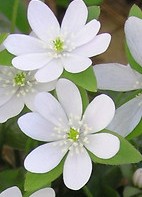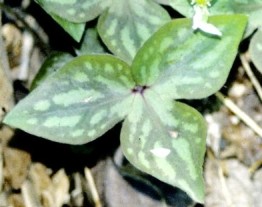 Sharp-lobed hepatica, also called heart liverleaf, is a herbaceous perennial in the buttercup family (Ranunculaeae) and is native to eastern US where it is found in moist shady woodlands. Although plants are very small, they can form a substantial carpet when once established. The leathery heart-shaped leaves are two inches long and wide with a hairy lower surface. They have three pointed lobes and are carried on hairy stems four to six inches high. Although they are dark green and often mottled in spring they turn russet to purple in the fall and persist through the winter. The cup-shaped flowers appear singularly on upright stems before the new leaves in very early spring and are white, lavender-blue or pale pink. Lacking petals, they are up to ½-1 inch across and consist of showy bracts surrounding delicate sepals and a center of yellow stamens. Flowers can last for up to two months. A beautiful selection for a woodland garden where they will get sun all winter but shade during the hot part of the year.
Sharp-lobed hepatica, also called heart liverleaf, is a herbaceous perennial in the buttercup family (Ranunculaeae) and is native to eastern US where it is found in moist shady woodlands. Although plants are very small, they can form a substantial carpet when once established. The leathery heart-shaped leaves are two inches long and wide with a hairy lower surface. They have three pointed lobes and are carried on hairy stems four to six inches high. Although they are dark green and often mottled in spring they turn russet to purple in the fall and persist through the winter. The cup-shaped flowers appear singularly on upright stems before the new leaves in very early spring and are white, lavender-blue or pale pink. Lacking petals, they are up to ½-1 inch across and consist of showy bracts surrounding delicate sepals and a center of yellow stamens. Flowers can last for up to two months. A beautiful selection for a woodland garden where they will get sun all winter but shade during the hot part of the year.
 Type: Herbaceous perennial
Type: Herbaceous perennial
Bloom: White, pale pink, or lavender-blue flowers in very early spring
Size: 4-6” H 6-12” W
Light: Partial shade except in winter
Soil: Humusy, evenly moist, well-drained
Hardiness: Zones 4-9
Care: Low maintenance
Pests and Diseases: Slugs may be a problem for new foliage
Propagation: Seed (needs stratification); division of clumps in fall with two to three buds in each division. Plants and slow growing and may take several years to flower; clumps are slow to increase.
Companion plants:
Claytonia virginica, Dicentra cucullaria, Dicentra canadensis, Erythronium americanum, Geranium maculatum, Phlox divaricata, Polygonatum pubescens , Sanguinaria canadensis, Trillium grandiflorum, Trillium recurvatum